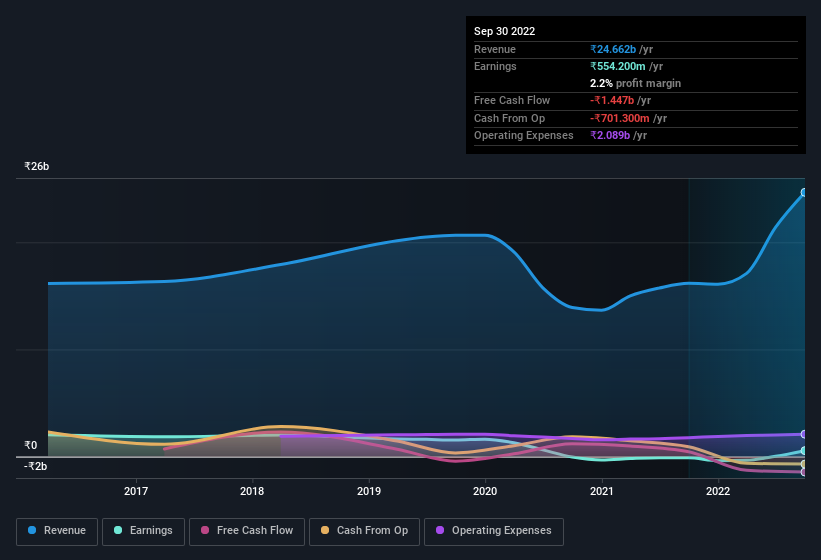Greaves Cotton's (NSE:GREAVESCOT) Earnings Are Weaker Than They Seem

Greaves Cotton Limited's (NSE:GREAVESCOT) robust earnings report didn't manage to move the market for its stock. We did some digging, and we found some concerning factors in the details.
Check out the opportunities and risks within the IN Machinery industry.

A Closer Look At Greaves Cotton's Earnings
Many investors haven't heard of the accrual ratio from cashflow, but it is actually a useful measure of how well a company's profit is backed up by free cash flow (FCF) during a given period. To get the accrual ratio we first subtract FCF from profit for a period, and then divide that number by the average operating assets for the period. You could think of the accrual ratio from cashflow as the 'non-FCF profit ratio'.
Therefore, it's actually considered a good thing when a company has a negative accrual ratio, but a bad thing if its accrual ratio is positive. While having an accrual ratio above zero is of little concern, we do think it's worth noting when a company has a relatively high accrual ratio. To quote a 2014 paper by Lewellen and Resutek, "firms with higher accruals tend to be less profitable in the future".
For the year to September 2022, Greaves Cotton had an accrual ratio of 0.36. We can therefore deduce that its free cash flow fell well short of covering its statutory profit, suggesting we might want to think twice before putting a lot of weight on the latter. In the last twelve months it actually had negative free cash flow, with an outflow of ₹1.4b despite its profit of ₹554.2m, mentioned above. It's worth noting that Greaves Cotton generated positive FCF of ₹455m a year ago, so at least they've done it in the past. One positive for Greaves Cotton shareholders is that it's accrual ratio was significantly better last year, providing reason to believe that it may return to stronger cash conversion in the future. As a result, some shareholders may be looking for stronger cash conversion in the current year.
That might leave you wondering what analysts are forecasting in terms of future profitability. Luckily, you can click here to see an interactive graph depicting future profitability, based on their estimates.
Our Take On Greaves Cotton's Profit Performance
As we have made quite clear, we're a bit worried that Greaves Cotton didn't back up the last year's profit with free cashflow. As a result, we think it may well be the case that Greaves Cotton's underlying earnings power is lower than its statutory profit. On the bright side, the company showed enough improvement to book a profit this year, after losing money last year. The goal of this article has been to assess how well we can rely on the statutory earnings to reflect the company's potential, but there is plenty more to consider. Keep in mind, when it comes to analysing a stock it's worth noting the risks involved. In terms of investment risks, we've identified 2 warning signs with Greaves Cotton, and understanding them should be part of your investment process.
This note has only looked at a single factor that sheds light on the nature of Greaves Cotton's profit. But there are plenty of other ways to inform your opinion of a company. For example, many people consider a high return on equity as an indication of favorable business economics, while others like to 'follow the money' and search out stocks that insiders are buying. So you may wish to see this free collection of companies boasting high return on equity, or this list of stocks that insiders are buying.
New: Manage All Your Stock Portfolios in One Place
We've created the ultimate portfolio companion for stock investors, and it's free.
• Connect an unlimited number of Portfolios and see your total in one currency
• Be alerted to new Warning Signs or Risks via email or mobile
• Track the Fair Value of your stocks
Have feedback on this article? Concerned about the content? Get in touch with us directly. Alternatively, email editorial-team (at) simplywallst.com.
This article by Simply Wall St is general in nature. We provide commentary based on historical data and analyst forecasts only using an unbiased methodology and our articles are not intended to be financial advice. It does not constitute a recommendation to buy or sell any stock, and does not take account of your objectives, or your financial situation. We aim to bring you long-term focused analysis driven by fundamental data. Note that our analysis may not factor in the latest price-sensitive company announcements or qualitative material. Simply Wall St has no position in any stocks mentioned.
About NSEI:GREAVESCOT
Greaves Cotton
Operates engineering and mobility retail business in India, Middle East, Africa, Southeast Asia, and internationally.
Adequate balance sheet slight.
Similar Companies
Market Insights
Community Narratives




